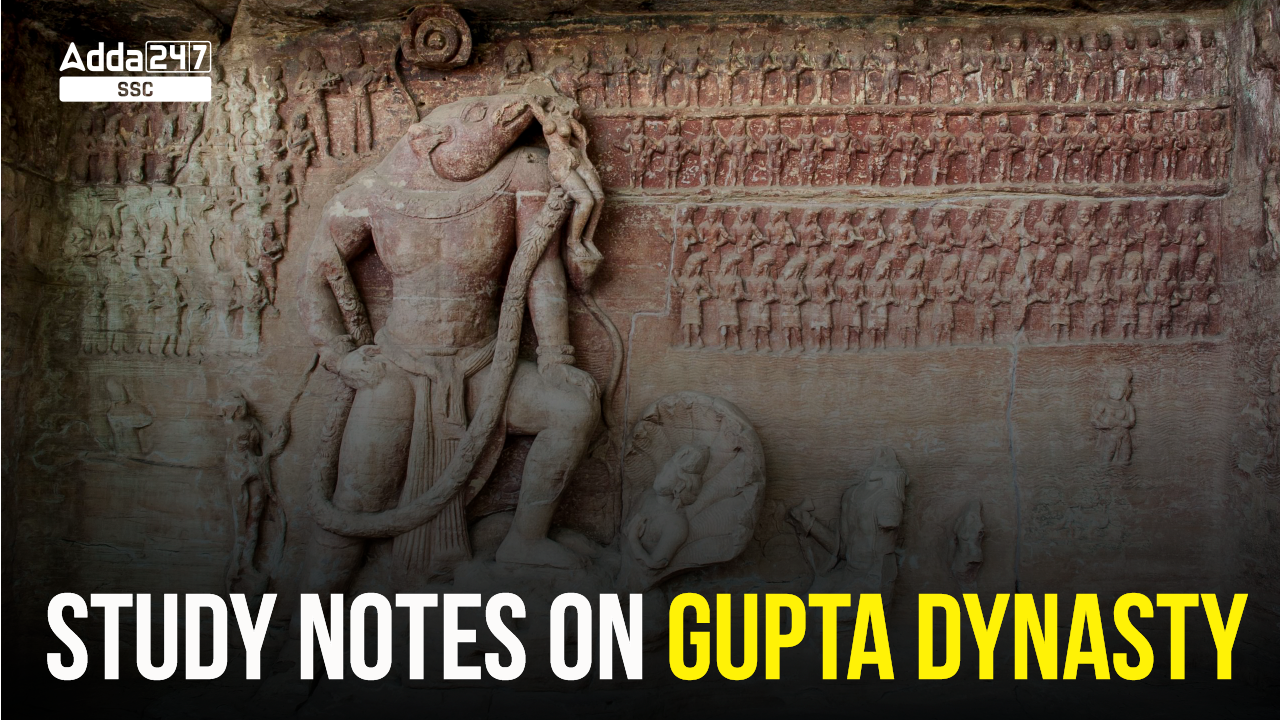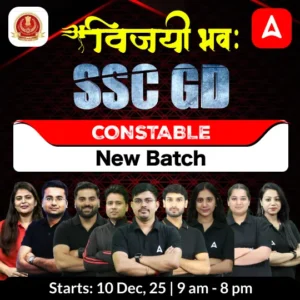Gupta Dynasty
Gupta Dynasty: Here we are providing important notes related to the Gupta Dynasty. The Gupta Empire was an ancient Indian Empire and Gupta dynasty was started by Sri Gupta, who ruled from 240 -280 CE. His son Ghatoksha (280- 319 CE. ) was the next successor of this Empire. Ghatoksha had a son named Chandragupta I (319-335 CE), Samudragupta and Chandragupta II, also known as Vikramaditya are the most notable rulers from the Gupta Dynasty. The Guptas conquered about twenty-one kingdoms from inside and outside the India, including the kingdoms of the Kambojas, Parasikas, Hunas, tribes in the west and east Oxus valleys, Kiratas and others. Historians consider this period as the golden age of India. Let’s look at the Gupta Dynasty in detail.
| Ruler | Reign |
|---|---|
| Gupta | (c. late 3rd century) |
| Ghatotkacha | (c. late 3rd century – 319) |
| Chandragupta I | (c. 319 – 335/350) |
| Kacha | (early 4th century?) |
| Samudragupta | (c. 335/350 – 375) |
| (Ramagupta) | (late 4th century?) |
| Chandragupta II | (380 – 413/415) |
| Kumaragupta I | (415 – 455) |
| Skandagupta | (455 – 467) |
| Purugupta | (467 – 473) |
| Kumaragupta II | (473 – 476) |
| Budhagupta | (476 – 495) |
| Narasimhagupta | (495 – ?) |
| (Bhanugupta) | (circa 510) |
| Vainyagupta | (circa 507) |
| Kumaragupta III | (circa 530) |
| Vishnugupta | (540 – 550 |
Gupta Dynasty: Overview
The Gupta Dynasty was established by Sri Gupta and enjoyed an overall reign of more than two centuries. The dynasty has a huge place in the books of the Ancient History of India due to its long-term impact on Indian culture and its contributions in Language, Religion, Trade, Foreign Relations, Literature, Art and Dance. For more details regarding the Gupta Dynasty, you can go through the information provided below.
| Name | Gupta Dynasty |
|---|---|
| Period | 320- 550 AD. |
| Language | Sanskrit (literary and academic); Prakrit (vernacular) |
| Religion | Hinduism, Buddhism, Jainism |
| Capital | Pataliputra |
Study Notes On Tughlaq Dynasty: Rulers, Dynasty and a Complete Overview
Gupta Empire Map
The disappearance of the Mauryas from the political map of India saw the emergence of many indigenous and foreign rulers, who divided north and south India and ruled over them for nearly five centuries.

The eclipse of the Kushanas in North India and of the Satavahanas in the Deccan in the 3rd century CE resulted in a period of political disintegration. It paved the way for the emergence of several minor powers and new ruling families. It was against this background the Guptas laid the foundation of the empire. After the Mauryas, Guptas realized the political unification of North India and covered much of the Indian subcontinent. The Gupta Empire stretched across northern, central, and parts of southern India between 320 and 550 CE. This was how the Gupta Empire map looked at the end of the 4th century.
Gupta Empire Kings
Gupta Empire was founded by Sri Gupta and it was succeeded by his son, Ghatotkacha. This dynasty rose to fame with rulers like Chandragupta-I, Samudragupta, etc. Details of some important Gupta Empire kings are given below:
Sri Gupta
- The founder of the Gupta dynasty was Sri Gupta.
- He was succeeded by Ghatotkacha.
- These two were called Maharajas.
Chandragupta I (320 – 330 A.D.)
- Chandragupta I and was the first to be called Maharajadhiraja (the great king of kings).
- He strengthened his position by a matrimonial alliance with the Licchavis.
- He married Kumaradevi, a princess of that family.
- The Mehrauli Iron Pillar inscription mentions his extensive conquests.
- Chandragupta I is considered to be the founder of the Gupta era which starts with his accession in A.D. 320.
Samudragupta (330-380 A.D.)
- Samudragupta was probably the greatest of the rulers of the Gupta dynasty.
- The Allahabad Pillar inscriptions provide a detailed account of Samudragupta’s reign.
- Samudragupta marched against the South Indian monarchs.
- He performed the asvamedha sacrifice.
- Samudragupta issued gold and silver coins with the legend ‘restorer of the asvamedha’.
- Because of his military achievements, Samudragupta was hailed as ‘Indian Napoleon’.
Chandragupta II (380-415 A.D.)
- Samudragupta was succeeded by his son Chandragupta II Vikramaditya.
- Through matrimonial alliances, Chandragupta II strengthened his political power.
- Chandragupta II married Kuberanaga, she was a Naga princess of central India.
- The greatest military achievement of Chandragupta II was his war against the Saka satraps of western India.
- After his victory, he performed the horse sacrifice and assumed the title Sakari, meaning, ‘destroyer of Sakas’. He also called himself ‘Vikramaditya’.
- Ujjain was an important commercial city and was the alternative capital of the Guptas.
- The great wealth of the Gupta Empire was manifest in the variety of gold coins.
- Famous Chinese pilgrim, Fahien visited India during the reign of Chandragupta II. Fahien provided valuable information on the religious, social and economic condition of the Gupta empire.
Kumaragupta
- Kumaragupta was the son and successor of Chandragupta II.
- A number of coins were issued and his inscriptions are found all over the Gupta Empire.
- Kumaragupta also performed an asvamedha sacrifice.
- Kumaragupta laid the foundation of Nalanda University which emerged as an institution of international reputation.
- A powerful wealthy tribe called the ‘Pushyamitras’ defeated the Gupta army at the end of his reign.
Skandagupta
- A branch of the Huns from Central Asia made attempts to cross the Hindukush mountains and invade India.
- Skandagupta who really faced the Hun invasion.
- He fought successfully against the Huns and saved the empire.
Gupta Empire Religion
Gupta kings knew that the well-being of the empire lay in maintaining good relations with the various communities that existed. Gupta rulers patronized the Hindu religious tradition. However, this period also saw the peaceful coexistence of Brahmins and Buddhists and visits by Chinese travelers like Faxian (Fa Hien), a Buddhist monk. Brahmanism (Hinduism) was the Gupta Empire’s religion.
- They were devout Vaishnava (Hindus who worship the Supreme Creator as Vishnu) themselves, yet that did not prevent them from being tolerant towards the believers of Buddhism and Jainism.
- Buddhist monasteries received liberal donations.
As a pre-eminent site of education and cultural exchange, Nalanda prospered under their patronage. Jainism flourished in northern Bengal, Gorakhpur, Udayagiri and Gujarat. Several Jain establishments existed across the empire and Jain councils were a regular occurrence.
Gupta Empire Capital
The capital of the Gupta Empire was the city of Pataliputra. Today, the city is known as Patna, the capital of the Indian state of Bihar in northern India. The location of the Gupta Empire’s capital was along the Ganges River and this made it an important and strategic spot throughout its existence. Known since at least 490 BCE, it is considered one of the oldest continuously inhabited cities still in existence today.
Gupta Empire Achievements
The Gupta Empire existed from the mid-to-late 3rd century CE to 590 CE. At its zenith, from approximately 319 to 550 CE, it covered much of the Indian subcontinent and is called the Golden Age of India because of the numerous achievements in the field of arts, literature, science and technology. These are some of the major Gupta Empire achievements:
Mathematics
- During the Gupta period, there was no symbol for denoting ‘zero’. The mathematician Aryabhatta used the powers of ten with null coefficients to indicate ‘zero’.
- The Guptas used alphabetical letters to represent numbers.
- Another important concept developed during this time was Trigonometry.
Astronomy
- One of the important developments was Aryabhatta’s theory that the earth is round in shape and not flat.
- The theory of gravity was promulgated by the astronomers of the Gupta period.
Aryabhatta also proved that the earth revolves around its own axis every day
Literature
- Sanskrit became the primary language in the Gupta period
- Ramayana & Mahabharata were compiled during this period
- The primary themes of literature were poetry and romantic comedies.
- Chandragupta II had nine poets in his court. The supreme poet among these
nine was Kalidasa. - Poet and playwright Kalidasa created such epics as Abhijnanasakuntalam, Malavikagnimitram, Raghuvansha and Kumarsambhaba. Harishena composed Allahabad Prasasti, Sudraka wrote Mricchakatika, Vishakhadatta created Mudrarakshasa and Vishnusharma penned Panchatantra.
- Varahamihira wrote Brihatsamhita and also contributed to the fields of astronomy and astrology. Genius mathematician and astronomer Aryabhata wrote Surya Siddhanta which covered several aspects of geometry, trigonometry and cosmology. Shanku devoted himself to creating texts about Geography
Art & Architecture
- The Gupta Age is called the golden age of India in fields of art, science & literature
- Nagara & Dravidian styles of art evolved during this period
- Delhi iron pillar, 7 ½ feet Buddha statue & Deogarh temple are the finest example
of Gupta art - Mural paintings of Ajanta, which mainly depicted life stories of Buddha as in Jataka stories belong to this period (Paintings at Sigiria in Srilanka are influenced by Ajanta paintings)
Education
Nalanda University was established by Kumaragupta I in the 5th century. The university was an important learning center and was one of the first universities which provided hostels for the students. The Gupta rulers encouraged higher learning at the centers of higher education at Nalanda, Takshila, Ujjain, Vallabhi and Vikramshila. These universities become popular in the seventh and eighth centuries A.D.
Gupta Empire Timeline
The image given below depicts the Gupta Empire timeline. The first ruler was Sri Gupta, succeeded by his son Ghatotkacha and the last ruler was Vishnugupta.

Decline of the Gupta Dynasty
- During the reign of Skandagupta, the grandson of Chandragupta II, he was successful in taking revenge against the Huns and the Pushyamitras, but his empire was drained of finance and resources because of this and started to decline.
- Internal conflicts among their royal families also led to its weakening.
- During the reign of Budhagupta, the Vakataka ruler Narendrasena of western Deccan attacked Malwa, Mekala and Kosala. Another Vakataka king Harishena conquered Malwa and Gujarat from the Guptas.
- Rulers emerged all over the North like Yasodharman of Malwa, the Maitrakas in Saurashtra, Mukharis of U.P and others in Bengal. The Gupta Empire was restricted to Magadha only.
- Yasodharman had joined forces with Narasimhagupta to successfully retaliate against the Hun Chief Mihirakula.
- Later Guptas’ following of Buddhism rather than Hinduism unlike their ancestors also weakened the empire. They did not focus on empire-building and military conquests.
- By the beginning of the sixth century, the empire had disintegrated and was ruled by many regional tribal chiefs.
- The last recognized king of the Gupta Dynasty was Vishnugupta who reigned from 540 AD to 550 AD.
Important Points to Remember
- The Gupta period witnessed tremendous progress in the fields of art, science and literature and on account of this it has been called “a golden age”.
- The temple at Deogarh near Jhansi and the sculptures in the temple at Garhwas near Allahabad remain important specimens of the Gupta art.
- The Bhitari monolithic pillar of Skandagupta is also remarkable.
- The paintings of the Gupta period are seen at Bagh caves near Gwalior.
- The paintings at Sigiriya in Sri Lanka were highly influenced by the Ajanta style.
- The Gupta coinage was also remarkable. Samudragupta issued eight types of gold coins.
- Chandragupta II and his successors had also issued gold, silver and copper coins of different varieties.
- The Sanskrit language became prominent during the Gupta period. The best of the Sanskrit literature belonged to the Gupta age.
- Samudragupta, a great poet patronized a number of scholars including Harisena.
- The court of Chandragupta II was adorned by the celebrated Navratnas. Kalidasa remains the foremost among them.
- The Panchatantra stories were composed during the Gupta period.
- The Puranas in their present form were composed during this period.
- The Mahabharata and the Ramayana were written in the present form and given final touches and written in the present form during this period.
- The Gupta period witnessed brilliant activity in the sphere of mathematics, astronomy, astrology and medicine.
- Varahamihira composed Pancha Siddhantika, the five astronomical systems.
The General Awareness section in the competitive exams conducted by various government authorities holds major importance in the preparation as well as the selection process. The candidates who are preparing for the upcoming examinations can benefit a lot from this article as questions on the ‘Gupta Dynasty’ are very common in the General Awareness section of these exams. The details provided in this article will help them increase their overall scores.
| Check Other links: | |
| Parliament Of India | Mughal Empire |
| Tughlaq Dynasty | 8 Union Territories in India |



 Upcoming Government Exams, Complete Govt...
Upcoming Government Exams, Complete Govt...
 Govt Jobs 2025, Latest Upcoming Governme...
Govt Jobs 2025, Latest Upcoming Governme...
 SSC Exam Calendar 2025–26 Out, Check All...
SSC Exam Calendar 2025–26 Out, Check All...









